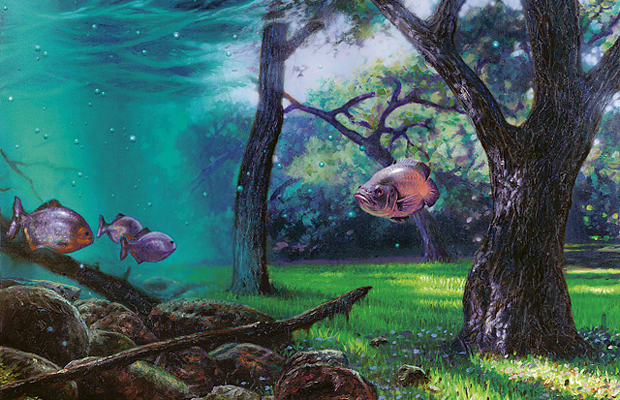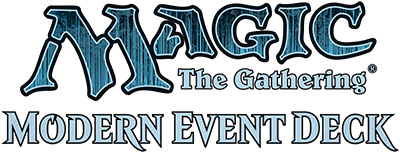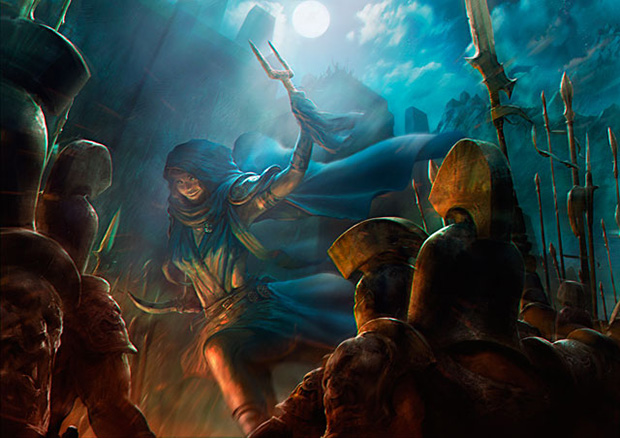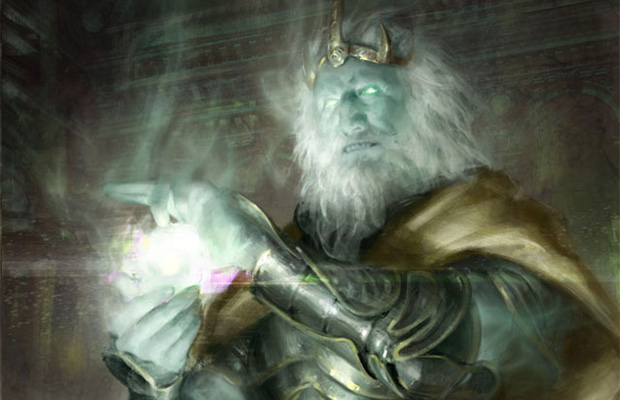By: Travis Allen
Now is a time of rejoice. Magic players have an especially good reason to celebrate and drink deep the joys of the season. In just a few short days, we get to say goodbye to Theros sealed PTQs permanently. On the first of June we wave goodbye to that godawful format and are rewarded with quite possibly the best constructed format in Magic: Modern.
We’ve got two things on the agenda for today. First, we’re going to chat about GP Minneapolis, a recent Modern event. Second, we’re going to consider our overall strategy heading into PTQ season.
GP Minneapolis came and went without a lot of fanfare. I didn’t see too much discussion on Twitter as we saw the Top 8 emerge, nor did i see much in the way of a post-mortem. There simply wasn’t anything too exciting for the community to take note of. But while the Top 16 was fairly predictable, there’s still some things we should paying attention to in the coming season.
The first thing that jumped out at me is the quantity of UWR decks that showed up in the Top 8. Three UWR lists and a PT win not long ago tells me that Bolt – Snap – Bolt is still pretty insane. Snapcaster Mage is clearly a major pillar of the format, and should be respected as such. He’s not at Dark Confidant levels yet, but he will be in due time. He’s certainly seeing more play than Confidant is at this point.
Restoration Angel has also firmly cemented her place in Modern by now. I’m kind of surprised she isn’t well over $10 already. Aside from being an angel, and therefore getting a big ol’ checkmark under the casual demand column, she’s quite obviously competitive. Her interaction with cheap value creatures like Snapcaster and Kitchen Finks is well known, she enables an EOT combo kill, and she only stands to get better as more enter-the-battlefield guys get printed. As we march forward into the season, be on the lookout for any in the binders of those emptying their Modern stock. I’ll be happy to trade for any copies people want to ship me.
Cryptic Command continues to be the best 1UUU spell in the format. While I won’t be picking up normal copies, I especially like the MPR printing since we’re unlikely to see those return in a very long time, if ever. Even if you aren’t personally wild about fishhand art, plenty of others will be. Demand exists for several MPR promos that look like butt.
Celestial Colonnade has made it to $20 and I see no reason why it shouldn’t keep going. It was a Buy-A-Box promo which means there’s an increased quantity available, but that was all the way back in Worldwake. Anything UW in Modern is running the full set. It definitely has the pedigree necessary to be the most expensive land in the format that doesn’t fetch. The tricky part is trying to figure out what it can/should reasonably cost. There isn’t really anything with a similar demand profile in Modern as best as I can tell. Grove of the Burnwillows is probably the closest, of which both printings are currently over $40. Of course Grove has Legacy demand which Colonnade doesn’t, but Colonnade has also been used much more in Modern than Grove since The Fall of Tron. (I’m capitalizing that because it sounds like a cool story). At the end of the day I’d say Colonnade should be at least as much as Grove, if not more. I also don’t see Colonnade showing up in an expert set this year or even next year. If you see a single dual-colored manland spoiler though, ship your copies on eBay that day.
Jund snuck two copies into the Top 16 with a playset of of Courser of Kruphix between them. I expect Courser is going to be around for awhile. Other than that, there wasn’t too much spice in the lists. I’m still seeing Pyromaster as a one-of but I don’t know how long that will last, and her value is only going to be dropping between now and September anyways.
The winning list was Scapeshift, but didn’t show us anything we didn’t already know. The namesake card made an immediate jump, but we’re way past capitalizing on that. Beyond Shift itself, it’s commons, Snapcaster, and Cryptic Command.
The other big showing was Pod, and boy did it ever. Seven of the Top 16 was Birthing Pod, so be dang sure you can beat it when you show up to a PTQ this summer. How that card is still only $12 is kind of a mystery to me. We saw it jump pretty drastically before Richmond, as well as many other Modern staples, but it has since settled quite a bit. Why is what is clearly the best card in both versions of the deck, decks which don’t seem any more expensive than many other tier one lists, under fifteen dollars? I literally do not have a good answer. Is it really just that New Phyrexia had enough supply in the market? That doesn’t seem likely. Is it a fear that the card will be banned? I do think that Pod is on the edge, but many competent strategists don’t seem to think we’ll be at that point before the next B&R change.
Gavony Township is nearly $4 at this point. It’s great in any deck that generates both green and white mana and has dudes, which surprisingly most decks that make those colors of mana do. It’s up from under a dollar a year or so ago, and probably stands to keep climbing into the $6-$10 range. If Pod does in fact get the axe, it’s not hard to imagine another GW list appearing at some point that wants it. It’s also pretty heavily tied into Innistrad flavor, so don’t expect to see more copies anytime soon.
While we’re chatting lands, Razorverge Thicket is both cheaper and more played than Blackcleave Cliffs at this point, with a better outlook to boot.
Linvala terrifies me as a hold. I have a single copy in my “never trade” binder and I’m half considering pulling it out and getting rid of it. This is absolutely getting reprinted at some point and it’s going to hurt when it does. If it crests $50 I may break and ship it. Avoid at all costs unless you 100% need it for your deck. There’s no real reason for it not to keep trending up as it has been, basically making her an expensive game of chicken.
Affinity only put a single copy in the Top 16, but that doesn’t mean the deck has fallen in popularity, just that enough people had a dedicated sideboard for it that weekend. There’s nothing really new here to work with. Arcbound Ravager is probably still a little lower than it should be, but not by much. The deck can’t get much better without running face first into a ban. (By the way, did you know how expensive Steel Overseer is? Hah.)
The bigger question to consider is just what to do with all of our Modern holdings. Earlier this year and late last year I was advocating near-complete liquidation in the coming weeks, but I’ve eased up on that a bit. I keep coming back to the notion that the game has grown beyond what any of us really fathomed a year ago, resulting in a surprising amount of demand for a relatively small supply. With so many Modern cards only getting less available by the day, is it really the best course of action to sell them all when they could gain anywhere from 20% to 300% by next year?
I’ve been pondering this quite a bit lately. I’m not sure how much others will share my opinions. I believe it has a great deal to do with how you manage your portfolio. Some individuals have cases at their local store that they buy/sell out of, which means churning through inventory is assuredly lucrative. Even if a particular card looks like a lock to rise in the future, they may find themselves better off selling it now and moving the profits into other cards that can do more in the shorter term. Meanwhile, those that operate with a much smaller number of transactions per week and less overall time in the market may find that they can’t capitalize on high turnover, and prefer to make their money with the slower sit-and-hold strategy. When to sell also depends heavily on how badly you need the cash, of course.
I’m finding that I’m looking to move some of my cards, but there is a chunk I may be holding onto unless they see enough of a rise. Format staples like Snapcaster I’m not going to mind holding onto if it’s a slow season for them. Let’s consider two possible futures for everyone’s favorite blue two-drop:
Timeline A: Snapcaster hits $45 during this Modern season and I choose not to sell. He settles to around $35 in the off-season. Before next year’s Modern PTQs, Modern Masters 2 is announced and Snapcaster is in. Like Cryptic Command before him, he drops to ~$20. All looks bleak. Though still like Cryptic Command, copies dry up as players acquire their sets. Demand steadily rises as less and less copies are available on the market, and eventually original copies are worth more than they were before MM2. The card is $55-$60+ in two years.
Timeline B: Snapcaster still hits $45 and I still choose not to sell. He dips to $35 in the off-season. There is no Modern Masters 2, and this time next year no new copies have hit the market. His price is now $60-$70 as he continues to be a the best blue card in Modern and a role-player in Legacy.
In either case, it’s likely that Snapcaster is worth more in one to two years than he is today. Being printed in a fall set would certainly hurt, but that is a very unlikely outcome. They won’t be in a rush to flashback Flashback. (Sorry). There is incentive to sell at $45 so that I can get my money out and move it somewhere else that will do even better, accepting the fact that the card will likely be worth more than I’m selling it for in a year or two. If he gets to $50-$60 I should probably sell because even in the best of circumstances he probably isn’t rising beyond $70 or $80, especially as reprints loom. If he doesn’t break $40, then I really should hold since in either scenario I make a good chunk of change on each copy in a year or two.
Cards that were in Modern Masters need to see an even greater rise for there to be sufficient reason to sell. By now everything has hit its floor. We’ve moved past the decline in prices and are into the stage where they’re either flatlining or rising. You can see the rise on Cryptic Command, Tarmogoyf, etc. Since those cards were just printed last year, I don’t think Wizards is going to be flooding us with even more copies of all of them. Assuming there’s a MM2 next year it’s likely some will come back, but not all. The stuff that doesn’t get reprinted between now and next June is just going to keep rising. If we don’t end up with more copies of Vendilion Clique or Dark Confidant before next June, they could easily gain 10%, 40%, or even more. This of course runs into the portfolio management mentioned above. If you’re a higher-frequency seller, it may be worth it to out your copies now and hop on the next card you see gaining that much in a quarter of the time. If you prefer to play it slow and sit on sure things, format pillars aren’t a bad place to camp. It may not make as much money overall, but it’s less risky and doesn’t require you to be able to identify the next big gainer.
If I’m not in a rush to sell format staples, what AM I looking to get rid of? Anything in the “flavor of the month” category can go. Amulet of Vigor. Azusa. Porphyry nodes. Scapeshift. Uncommons that people really need to play their decks that keep getting reprinted, such as Kitchen Finks, Lightning Helix and Path to Exile. Cards that have been floating around long enough that they may see a reprint, such as Spellskite, Damnation, Fulminator Mage, Threads of Disloyalty and Tectonic Edge. Cards that are pushing their effective ceiling, such as Mox Opal. Probably Fetchlands, although those are complex given that they’re format staples like Snapcaster and thus asking to be held while at the same time playing the “will they/won’t they” reprint game. (I’ll probably sell mine and move onto greener pastures, even though I don’t expect them in Khans). Odds and ends like Shadow of Doubt.
All of those cards I mentioned above could easily gain significant value by the time next Modern rolls around, but the risk of them losing value because of some unforeseeable cause – reprint, meta shift, ban change, etc – is too great to make it worth holding out for a few extra dollars. I’d much rather sell all my Threads for a good $20 today, completely willing to accept that I’m passing up the possibility of $30 next June, rather than get blown out by a Khans reprint and see them at $6.
Even though I’m not in a rush to sell cards like Snapcaster or Liliana of the Veil, I’m not necessarily looking to get further into them. The issue is that they’re gigantic question marks at this point in time. On a long enough time scale you’re unlikely to lose money on those types of cards because they will almost definitely end up more expensive than they are when you pick them up, but you may not be in the market to sit on Snapcasters for a few years because he got stuck in Speed vs. Cunning.
That leaves us in an awkward spot of looking to out 70% to 90% of our Modern holdings, but unlike the last eighteen months, we don’t want to just move all in on any card legal in that format. Where do we put our money now? The most available place is Standard. Standard cards are going to be ubiquitous, and people will be quite eager to ship Temples for Primeval Titans. Grabbing Standard cards requires a certain level of knowledge though, both of a myriad of prices and what is/isn’t a good pickup. The latter is tough in a format where there are so few slam dunks. Moving hundreds or thousands of dollars in Modern cards into Standard also has the added risk of making your portfolio considerably more volatile. Spellskites have been gold for months now, and you knew you could pick them up in trade and not have to worry about them hitting their peak and dropping in the span of three weeks. They were safe and easy. Very few Standard cards are going to have that feature. Instead, you’re going to need to keep close tabs on both your inventory and the format so that you can ship as soon as prices move in your favor. Not all of us enjoy watching Standard prices like a hawk week in and week out, so that’s quite a chore.
Another option is foils. Pack foils are incredibly tough to crack the value on, especially anything unique. Innistrad foil Lilianas and Snapcasters are likely to only maintain their value, no matter what happens. Deathrite Shaman foils didn’t take a hit at all when they were banned, and many seem to think he’ll be unbanned down the road. Foil casual staples like Temporal Mastery are fertile ground. If you’re moving enough to generate serious cash, big-ticket items are excellent places to put your money. Pack foil Onslaught fetches, duals, and even Power are all great options. Of course these are clearly difficult to trade for. Chances are that if you’re getting rid of enough product to have enough to afford those, you’re probably selling instead of trading though.
Sealed product is as safe as Modern staples were circa August 2013, but don’t expect as fast a return. Boxes of Return to Ravnica are a great target at the moment, but it will take some time before you really get paid on that. Sealed Innistrad boxes have only recently started breaking $200 on eBay, and those were one of the fastest rising booster boxes since the borders changed. Sealed Ravnica cases certainly do handle scale well though. It’s easy to sink money into, and I don’t even see sealed Innistrad cases in a cursory glance.
The long and short of it is that when Modern Masters came out, those of us looking to invest couldn’t have had it easier. Prices on staples guaranteed to rise were in a temporary valley. If a card showed up in a Modern decklist at any point anywhere it was fine to stash. You couldn’t lose money. I feel like with this PTQ season we’re crossing a border though, and between now and next summer it’s going to be a lot dicier to find cards that are as easy to trade for and as lucrative as Modern staples were. Cards that stand to gain as much now as the ones last summer did will be harder to find and will be riskier to hold.
I’m sharing all of this with you guys, but I’ll be completely upfront that I’m willing to adjust my plan if necessary. This is my line of thinking and how I plan on approaching the coming months. I’m happy to listen to alternative viewpoints backed by solid logic that suggest other lines of play though. I’m sure at least one of the other guys who do this day in and day out will disagree with me somewhere, and I’m curious to hear how.




